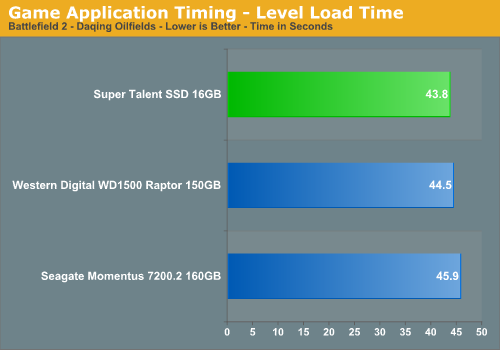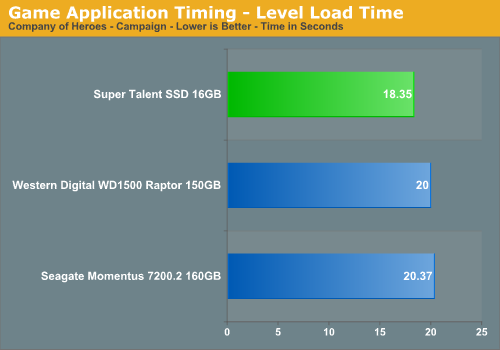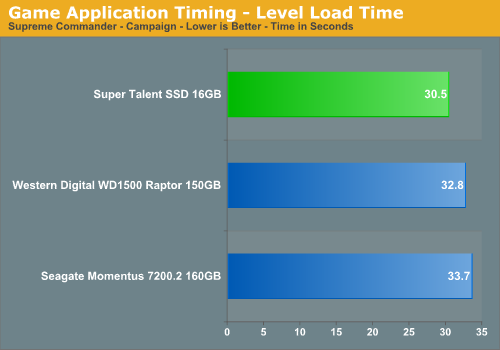Super Talent SSD: 16GB of Solid State Goodness
by Gary Key on May 7, 2007 4:00 AM EST- Posted in
- Storage
Actual Application Times - Gaming
Our application benchmarks are designed to show application performance results with times being reported in seconds, with lower scores being better. While these tests will show differences between the drives it is important to understand we are not measuring the synthetic performance of the hard drive but how well our platform performs with each individual drive. The performance of a drive is an integral part of the computer platform but other factors such as memory, CPU, core logic, and even driver choice can play a major role in determining how well the drive performs in any given task.
Game Level Load
Our tests center on the actual loading of a playable level within our game selections. It is obvious this drive is not intended to be used in gaming systems and we debated on even including these results. However, for game level loads the burst/sustained read speed and access time of a drive is very important. Considering Solid State Drives excel in low access (latency) times we thought it would be interesting to see how well this drive performed in our game tests.
The Battlefield 2 test measures the time it takes to load the Daqing Oilfields level. Our application timer begins when the start single player icon is initiated and ends when the join game icon is visible.

This is one of the more demanding game level load times we test and the Super Talent drive scores first although the margin is minimal. We fully expect the faster consumer level SSD products to improve upon these scores. After several hours of game play we could tell a slight difference between the drives in this test. The SSD product always seemed to load the levels in a smoother manner than our two hard disks, although it was difficult to determine any actual speed differences.
The Company of Heroes test measures the time it takes to load the first campaign level. Our application timer begins when the start single player icon is initiated and ends when the join game icon is visible.

Once again we see a minimal difference between our drives but the Super Talent drive is about 8% faster at loading this particular level. In repeated testing it was difficult to discern the differences between the drive setups but when compared to the Raptor the Super Talent drive is eerily quiet while playing the game. It took a little time to adjust to the acoustic differences not to mention our overall case temperatures being 3C lower after an hour of testing.
Our Supreme Commander test measures the time it takes to load the first campaign level. Our application timer begins when the start single player icon is initiated and ends when the join game icon is visible.

In our final game test the Super Talent drive is around 7% quicker at loading this particular campaign. We did not notice any issues throughout the full campaign scenario and as in the Battlefield 2 tests, the loading of the cut scenes and actual game levels was smoother although we did not perceive any differences in performance.
Our application benchmarks are designed to show application performance results with times being reported in seconds, with lower scores being better. While these tests will show differences between the drives it is important to understand we are not measuring the synthetic performance of the hard drive but how well our platform performs with each individual drive. The performance of a drive is an integral part of the computer platform but other factors such as memory, CPU, core logic, and even driver choice can play a major role in determining how well the drive performs in any given task.
Game Level Load
Our tests center on the actual loading of a playable level within our game selections. It is obvious this drive is not intended to be used in gaming systems and we debated on even including these results. However, for game level loads the burst/sustained read speed and access time of a drive is very important. Considering Solid State Drives excel in low access (latency) times we thought it would be interesting to see how well this drive performed in our game tests.
The Battlefield 2 test measures the time it takes to load the Daqing Oilfields level. Our application timer begins when the start single player icon is initiated and ends when the join game icon is visible.

This is one of the more demanding game level load times we test and the Super Talent drive scores first although the margin is minimal. We fully expect the faster consumer level SSD products to improve upon these scores. After several hours of game play we could tell a slight difference between the drives in this test. The SSD product always seemed to load the levels in a smoother manner than our two hard disks, although it was difficult to determine any actual speed differences.
The Company of Heroes test measures the time it takes to load the first campaign level. Our application timer begins when the start single player icon is initiated and ends when the join game icon is visible.

Once again we see a minimal difference between our drives but the Super Talent drive is about 8% faster at loading this particular level. In repeated testing it was difficult to discern the differences between the drive setups but when compared to the Raptor the Super Talent drive is eerily quiet while playing the game. It took a little time to adjust to the acoustic differences not to mention our overall case temperatures being 3C lower after an hour of testing.
Our Supreme Commander test measures the time it takes to load the first campaign level. Our application timer begins when the start single player icon is initiated and ends when the join game icon is visible.

In our final game test the Super Talent drive is around 7% quicker at loading this particular campaign. We did not notice any issues throughout the full campaign scenario and as in the Battlefield 2 tests, the loading of the cut scenes and actual game levels was smoother although we did not perceive any differences in performance.










44 Comments
View All Comments
Hulk - Monday, May 7, 2007 - link
Since Flash memory is so cheap how come some manufacturer can't make a hard drive unit where you can plug in identical memory cards? You can get 4GB modules for less than $40 these days. 8x40=$320 for 32GB. Using a Raid type parallel access scheme you should be able to get 8 times the performance of one module. So if one module can write at 6MB/sec then 6x8=48MB/sec.Plus if a module starts to fail you could replace it.
These are just questions from someone that only has a basic understanding of this technology of course. If it could work I'm sure someone would be doing it. I'm curious as to the specifics of why this idea would not be feasible.
PandaBear - Thursday, May 10, 2007 - link
Because the cheap nand doesn't last 100k (MLC) and they are slow. Example:Sandisk CF cost around $10/gb and is around 10MB/S if trimmed to high performance (Ultra II), and 20MB/S if running parallel internally (Extreme III)
The same CF capacity will cost 1.5x to make it 40MB/S in parallel but gives you very high reliability (250k to 1M write/erase).
So there you have it, for HD you better play it save and use expensive nand, and it won't cost $10/GB
miahallen - Wednesday, May 9, 2007 - link
One of these:http://www.newegg.com/Product/Product.aspx?Item=N8...">http://www.newegg.com/Product/Product.aspx?Item=N8...
Four of these:
http://www.newegg.com/Product/Product.aspx?Item=N8...">http://www.newegg.com/Product/Product.aspx?Item=N8...
And, four of these:
http://www.newegg.com/Product/Product.aspx?Item=N8...">http://www.newegg.com/Product/Product.aspx?Item=N8...
$340 total for 32GB - In a RAID0 that would be rated speed of 80MB/s read, 72MB/s write, and still great random access speeds.
Ajax9000 - Monday, May 7, 2007 - link
There are CF2IDE and CF2SATA adapters (e.g. see this list http://www.addonics.com/products/flash_memory_read...">http://www.addonics.com/products/flash_memory_read... ).For about the same price as the SuperTalent 16GB SSD you could build a 32GB IDE SSD using two 16GB CF cards and a dual slot CF2IDE adapter.
BTW, DansData looked at this sort of thing back in 2000 (http://www.dansdata.com/cfide.htm">http://www.dansdata.com/cfide.htm ) and earlier this year (http://www.dansdata.com/flashswap.htm">http://www.dansdata.com/flashswap.htm ) but didn't go into performance details.
I think it would be very interesting if Anandtechs' upcoming review of consumer oriented SSD products also looked at CF2IDE and CF2SATA adapters as an interim solution untill "proper" SSDs get somewhat cheaper.
Are there issues with this? Of course, but they may be reasonable tradeoffs.
IDE vs SATA
The SuperTalent review notes that SSDs tend not to be interface bound at the moment so there may not be much difference between SATA and IDE for SSDs. Also, as CF uses an IDE interface (and I understand that the CF2IDE adapters are little more than physical connects) using a CF2IDE adaptor shouldn't impact on performance either ... as long as the I/O controller in the CF card is good (and there are 133x and 150x CF cards in 12 & 16 gig)
Wearout
Reflex's comments are a fairly typical concern with respect to the use of flash memory in consumer PCs. And if there was no wear-levelling or ECC on consumer CF cards they simply couldn't be used for swap files etc. BUT someone has commented on DailyTech that that flash cards commonly have memory controllers which do wear levelling and/or ECC (http://www.dailytech.com/article.aspx?newsid=7135&...">http://www.dailytech.com/article.aspx?n...&com... ). Even so, it would seem dangerous to have the OS and swap on the same card.
The thing I like about the double CF2IDE adaptor (and what I'd like to see someone such as AnadTech test out :-) is the possibility of having swap on a smaller/cheaper card (say 4GB?), so NAND wearout of the swap can be contained to a more affordably replaced item.
In summary compare the price and performance of a dual-CF2IDE adapter + 12/16GB CF (OS+apps) + 4/8GB CF (swap) against a 16/32GB SSD.
Adrian
Reflex - Tuesday, May 8, 2007 - link
Just to make something clear: Wear leveling is not a magic pancea. The ratings they give are taking wear leveling into account. It is not "100K writes + wear leveling to stretch it further" its "100k writes due to our wear leveling technique". Even without a swap file, for a typical workstation you would use that up fairly rapidly. I am going to go out on a limb though and guess that they probably have more like 250-500k writes, but are only guaranteeing it for 100k to protect themselves. For the market these are designed for, 100k writes is more than the machines will likely use in their service lifetime. For a desktop PC, however, it would wear out very very quickly as I have stated above.Ajax9000 - Tuesday, May 8, 2007 - link
Thanks Reflex.I'm still curious re the performance comparison, as well as the TCO/longevity issue. :-)
yyrkoon - Monday, May 7, 2007 - link
Just a guess, but I think it would be a nightmare desiging a controller that could address mutliple 'Flash Drives'. Lets take your typical SD card for example, whatever it plugs into has one controller for the card, and if what you're saying were to happen, you would need multiple controllers, all talking to a main controller, which then in turn would communicate with the actual HDD controller. This would be slow, and problematic, especially when data spanned one or more memory media device. I am not saying it could not be done, and may even possibly done well, but there are other factor such as liscencing fees, and controller costs, etc.As an example, do you have any idea what it takes to get your hands on a legitimit copy of the SATA specification ? Last I looked, its ~$500 for the design specifications 'book', and every device you make that uses the technology requires a liscencing fee. In other words, it is not cheap, I would imagine the same applies for SD controllers (or whatever form of media said OEM would choose/support), and one normally goes into business to make money, and this would likely eat deeply into the pockets of the share holders.
I can think of more reasons, and the ones given may not be entirerly accurate, but this should give you some idea as to 'why'.
JoshuaBuss - Monday, May 7, 2007 - link
I would love to know the exact same thing. You can buy 4gb SD cards for $40.. 2gb for $20 if you shop around. Flash memory seems to be practically given away these days.. it's so friggin cheap.Lonyo - Monday, May 7, 2007 - link
I think they are doing it. IIRC there was something posted on DailyTech about a card which used regular memory cards and hooked up to a SATA/PATA interface. I think anyway, not 100% sure.yacoub - Monday, May 7, 2007 - link
well i guess they gotta start somewhere :D